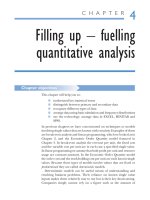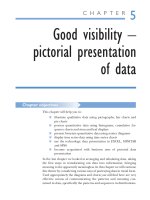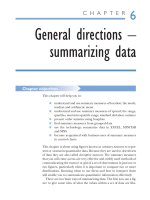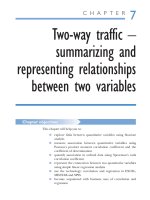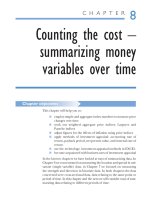Quantitative methods for business
Bạn đang xem bản rút gọn của tài liệu. Xem và tải ngay bản đầy đủ của tài liệu tại đây (10.43 MB, 644 trang )
Quantitative Methods for Business, fourth edition, employs an accessible five-part
structure, leading the reader through the subject in a logical sequence.
•
•
•
•
•
Part One introduces the subject, asks why managers use quantitative
methods and reviews essential quantitative tools
Part Two covers data collection and description, focusing in particular on
how to ensure your data is reliable
Part Three shows how quantitative methods can be used for solving
different types of problems
Part Four describes some statistical methods, focusing on probabilities,
sampling and statistical inference
Part Five suggests how statistical ideas may be used in decision analysis,
quality management, inventory control and other areas
Key features
• Worked examples illustrate the principles discussed
• ‘Ideas in practice’ sections show how methods are actually used
• Covers a broad range of materials relevant to managers and students
• Case studies at the end of every chapter consolidate learning objectives
• Extensive pedagogical features, including self-assessment problems, chapter
outlines and summaries, review questions and suggested research projects
QUANTITATIVE METHODS
FOR BUSINESS FOURTH EDITION
All students of management undertake a course in quantitative
methods. These courses come in various guises, including
quantitative analysis, decision analysis, business modelling and
numerical analysis. This book describes a range of quantitative
methods that are widely used in business and which every
student of management will meet somewhere in their course.
Whether studying for an HND, an MBA, a first degree or a
professional qualification, students will appreciate the author’s
friendly style and practical approach.
Donald Waters
QUANTITATIVE
METHODS
FOR
BUSINESS
FOURTH EDITION
Waters
About the author
Donald Waters is the author of several successful textbooks and is well
known for his clarity of style and his student-friendly texts.
Front cover image:
© Getty Images
an imprint of
9780273694588_COVER.indd 1
Additional student support at
www.pearsoned.co.uk/waters
www.pearson-books.com
31/7/07 15:12:45
QUAM_A01.qxd
8/3/07
1:18 PM
Page i
Quantitative Methods
for Business
Visit the Quantitative Methods for Business,
Fourth Edition Companion Website at
www.pearsoned.co.uk/waters to find valuable
student learning material including:
n
n
n
n
n
n
..
Data sets for problems, examples and cases in the
book
Spreadsheet templates for calculations
Additional material to extend the coverage of key
topics
Proofs and derivations of formulae
Answers to problems
Additional worked examples and case studies
QUAM_A01.qxd
8/3/07
1:18 PM
Page ii
We work with leading authors to develop the strongest
educational materials in business, bringing cutting-edge
thinking and best learning practice to a global market.
Under a range of well-known imprints, including Financial
Times Prentice Hall, we craft high quality print and
electronic publications which help readers to understand
and apply their content, whether studying or at work.
To find out more about the complete range of our
publishing please visit us on the World Wide Web at:
www.pearsoned.co.uk
..
QUAM_A01.qxd
8/3/07
1:18 PM
Page iii
Quantitative
Methods for
Business
FOURTH EDITION
Donald Waters
..
QUAM_A01.qxd
8/3/07
1:18 PM
Page iv
Pearson Education Limited
Edinburgh Gate
Harlow
Essex CM20 2JE
England
and Associated Companies throughout the world
Visit us on the World Wide Web at:
www.pearsoned.co.uk
First published 1993
Second edition published under the Addison-Wesley imprint 1997
Third edition published 2001
Fourth edition published 2008
© Pearson Education Limited 1997, 2001
© Donald Waters 2008
The right of Donald Waters to be identified as author of this work has
been asserted by him in accordance with the Copyright, Designs and Patents Act 1988.
All rights reserved. No part of this publication may be reproduced, stored in a
retrieval system, or transmitted in any form or by any means, electronic, mechanical,
photocopying, recording or otherwise, without either the prior written permission of the
publisher or a licence permitting restricted copying in the United Kingdom issued by the
Copyright Licensing Agency Ltd, Saffron House, 6–10 Kirby Street, London EC1N 8TS.
All trademarks used herein are the property of their respective owners. The use of any
trademark in this text does not vest in the author or publisher any trademark ownership
rights in such trademarks, nor does the use of such trademarks imply any affiliation with or
endorsement of this book by such owners.
The screenshots in this book are reprinted by permission from Microsoft Corporation.
ISBN 978-0-273-69458-8
British Library Cataloguing-in-Publication Data
A catalogue record for this book is available from the British Library
10 9 8 7 6 5 4 3 2 1
11 10 09 08 07
Typeset in 10/12pt Sabon by 35
Printed by Ashford Colour Press Ltd, Gosport
The publisher’s policy is to use paper manufactured from sustainable forests.
..
..
QUAM_A01.qxd
8/3/07
1:18 PM
Page v
TO CHARLES
..
..
QUAM_A01.qxd
8/3/07
1:18 PM
Page vi
..
QUAM_A01.qxd
8/3/07
1:18 PM
Page vii
BRIEF CONTENTS
Preface
Part One – Background
1 Managers and numbers
2 Quantitative tools
3 Drawing graphs
Part Two – Collecting and summarising data
4
5
6
7
..
Collecting data
Diagrams for presenting data
Using numbers to describe data
Describing changes with index numbers
xvii
1
3
18
43
63
65
90
120
148
Part Three – Solving management problems
167
8
9
10
11
12
13
169
200
232
265
289
319
Finance and performance
Regression and curve fitting
Forecasting
Simultaneous equations and matrices
Planning with linear programming
Rates of change and calculus
Part Four – Introducing statistics
341
14
15
16
17
343
366
397
419
Uncertainty and probabilities
Probability distributions
Using samples
Testing hypotheses
Part Five – Management problems with uncertainty
447
18
19
20
21
22
449
478
504
528
555
Making decisions
Quality management
Inventory management
Project networks
Queues and simulation
QUAM_A01.qxd
viii
8/3/07
1:18 PM
Page viii
Brief contents
Glossary
Appendices
Appendix A
Appendix B
Appendix C
Appendix D
Appendix E
Appendix F
Index
575
Solutions to review questions
Probabilities for the binomial distribution
Probabilities for the Poisson distribution
Probabilities for the Normal distribution
Probabilities for the t-distribution
Critical values for the χ2 distribution
587
601
606
610
611
612
614
..
QUAM_A01.qxd
8/3/07
1:18 PM
Page ix
CONTENTS
Preface
Part One – Background
1 Managers and numbers
Chapter outline
Why use numbers?
Solving problems
Useful software
Chapter review
Case study – Hamerson and Partners
Problems
Research projects
Sources of information
2 Quantitative tools
Chapter outline
Working with numbers
Changing numbers to letters
Powers and roots
Chapter review
Case study – The Crown and Anchor
Problems
Research projects
Sources of information
3 Drawing graphs
Chapter outline
Graphs on Cartesian co-ordinates
Quadratic equations
Drawing other graphs
Chapter review
Case study – McFarlane & Sons
Problems
Research projects
Sources of information
Part Two – Collecting and summarising data
4 Collecting data
Chapter outline
Data and information
..
xvii
1
3
3
3
7
11
14
14
15
15
16
18
18
19
25
31
39
39
40
41
41
43
43
43
51
55
59
60
61
62
62
63
65
65
65
QUAM_A01.qxd
x
8/3/07
1:18 PM
Page x
Contents
Types of data
Using samples to collect data
Organising data collection
Chapter review
Case study – Natural Wholemeal Biscuits
Problems
Research projects
Sources of information
5 Diagrams for presenting data
Chapter outline
Data reduction and presentation
Tables of numerical data
Diagrams of data
Continuous data
Chapter review
Case study – High Acclaim Trading
Problems
Research projects
Sources of information
6 Using numbers to describe data
Chapter outline
Measuring data
Measures of location
Measures of spread
Other measures of data
Chapter review
Case study – Consumer Advice Office
Problems
Research projects
Sources of information
7 Describing changes with index numbers
Chapter outline
Measuring change
Changing the base period
Indices for more than one variable
Chapter review
Case study – Heinz Muller Engineering
Problems
Research projects
Sources of information
Part Three – Solving management problems
8 Finance and performance
Chapter outline
Measures of performance
Break-even point
69
72
79
86
87
88
89
89
90
90
90
93
98
109
115
116
117
119
119
120
120
120
122
133
141
145
145
146
146
147
148
148
148
154
156
161
162
163
164
165
167
169
169
169
174
..
..
QUAM_A01.qxd
8/3/07
1:18 PM
Page xi
Contents
Value of money over time
Discounting to present value
Mortgages, annuities and sinking funds
Chapter review
Case study – OnlineInkCartridges.com
Problems
Research projects
Sources of information
9 Regression and curve fitting
Chapter outline
Measuring relationships
Linear relationships
Measuring the strength of a relationship
Multiple regression
Curve fitting
Chapter review
Case study – Western General Hospital
Problems
Research projects
Sources of information
10 Forecasting
Chapter outline
Forecasting in organisations
Judgemental forecasts
Projective forecasts
Forecasts with seasonality and trend
Chapter review
Case study – Workload planning
Problems
Research projects
Sources of information
11 Simultaneous equations and matrices
Chapter outline
Simultaneous equations
Matrix notation
Matrix arithmetic
Using matrices to solve simultaneous equations
Chapter review
Case study – Northern Feedstuffs
Problems
Research projects
Sources of information
12 Planning with linear programming
Chapter outline
Constrained optimisation
Formulation
..
..
xi
181
184
192
195
195
196
198
198
200
200
200
205
212
218
223
227
227
228
230
231
232
232
232
235
237
251
261
261
262
263
263
265
265
265
271
273
282
285
286
286
287
288
289
289
290
290
QUAM_A01.qxd
xii
8/3/07
1:18 PM
Page xii
Contents
Using graphs to solve linear programmes
Sensitivity of solutions to changes
Solving real problems
Chapter review
Case study – Elemental Electronics
Problems
Research projects
Sources of information
13 Rates of change and calculus
Chapter outline
Differentiation
Finding the maximum and minimum
Marginal analyses
Integration
Chapter review
Case study – Lundquist Transport
Problems
Research projects
Sources of information
296
302
304
313
313
314
317
318
319
319
319
324
330
333
337
337
338
339
339
Part Four – Introducing statistics
341
14 Uncertainty and probabilities
343
343
343
347
353
361
362
363
364
364
Chapter outline
Measuring uncertainty
Calculations with probabilities
Conditional probabilities
Chapter review
Case study – The Gamblers’ Press
Problems
Research projects
Sources of information
15 Probability distributions
Chapter outline
Frequency distributions
Combinations and permutations
Binomial distribution
Poisson distribution
Normal distribution
Chapter review
Case study – Machined components
Problems
Research projects
Sources of information
16 Using samples
Chapter outline
Purpose of sampling
366
366
366
368
371
376
382
393
394
394
396
396
397
397
397
..
..
QUAM_A01.qxd
8/3/07
1:18 PM
Page xiii
Contents
Sampling distribution of the mean
Confidence intervals
One-sided confidence intervals
Using small samples
Chapter review
Case study – Kings Fruit Farm
Problems
Research projects
Sources of information
17 Testing hypotheses
Chapter outline
Aim of hypothesis testing
Significance levels
Tests with small samples
Testing other hypotheses
Chi-squared test for goodness of fit
Tests of association
Chapter review
Case study – Willingham Consumer Protection Department
Problems
Research projects
Sources of information
419
419
420
423
428
429
434
439
441
442
443
445
445
447
18 Making decisions
449
19 Quality management
Chapter outline
Measuring quality
Quality control
Tools for quality control
Acceptance sampling
Process control
Chapter review
Case study – Bremen Engineering
Problems
..
399
403
409
411
415
415
416
417
418
Part Five – Management problems with uncertainty
Chapter outline
Giving structure to decisions
Decision making with certainty
Decision making with uncertainty
Decision making with risk
Sequential decisions
Chapter review
Case study – The Newisham Reservoir
Problems
Research projects
Sources of information
..
xiii
449
449
452
453
458
465
472
473
473
476
477
478
478
478
484
486
490
495
498
499
500
QUAM_A01.qxd
xiv
8/3/07
1:18 PM
Page xiv
Contents
Research projects
Sources of information
20 Inventory management
Chapter outline
Background to stock control
The economic order quantity
Stock control for production
Variable demand
Periodic review
ABC analysis of stock
Chapter review
Case study – Templar Manufacturing
Problems
Research projects
Sources of information
21 Project networks
Chapter outline
Network analysis
Drawing project networks
Timing of projects
Project evaluation and review technique
Chapter review
Case study – Westin Contractors
Problems
Research projects
Sources of information
22 Queues and simulation
Chapter outline
Features of queues
Single-server queues
Simulation models
Monte Carlo simulation
Chapter review
Case study – The Palmer Centre for Alternative Therapy
Problems
Research projects
Sources of information
501
502
504
504
504
508
513
515
518
521
523
524
525
526
527
528
528
528
530
535
545
549
550
550
552
554
555
555
555
557
560
565
572
572
573
574
574
Glossary
575
Appendix A
Solutions to review questions
587
Appendix B
Probabilities for the binomial distribution
601
Appendix C
Probabilities for the Poisson distribution
606
..
..
QUAM_A01.qxd
8/3/07
1:18 PM
Page xv
Contents
xv
Appendix D
Probabilities for the Normal distribution
610
Appendix E
Probabilities for the t-distribution
611
Appendix F
Critical values for the χ2 distribution
612
Index
614
Supporting resources
Visit www.pearsoned.co.uk/waters to find valuable online resources
Companion Website for students
n Data sets for problems, examples and cases in the book
n Spreadsheet templates for calculations
n Additional material to extend the coverage of key topics
n Proofs and derivations of formulae
n Answers to problems
n Additional worked examples and case studies
For instructors
n Complete, downloadable Instructor’s Manual
n PowerPoint slides that can be downloaded and used for
presentations
n Review of key aims and points of each chapter
n Worked solutions to problems
n Comments on case studies
n Copies of figures and artwork from the book
n Additional worked examples and case studies
Also: The Companion Website provides the following features:
n
n
n
Search tool to help locate specific items of content
E-mail results and profile tools to send results of quizzes to
instructors
Online help and support to assist with website usage and
troubleshooting
For more information please contact your local Pearson Education
sales representative or visit www.pearsoned.co.uk/waters
..
..
QUAM_A01.qxd
8/3/07
1:18 PM
Page xvi
..
QUAM_A01.qxd
8/3/07
1:18 PM
Page xvii
P R E FA C E
Managers are the people who run their organisations. They need many skills
for this – including problem-solving, leadership, communications, analysis,
reasoning, experience, judgement, and so on. They also have to understand
quantitative methods, which give essential tools for making rational decisions
in complex circumstances. This does not mean that managers have to be
professional mathematicians, but they do need to understand quantitative
reasoning and interpret numerical results.
All students of management do a course in quantitative methods. These
courses come in various guises, including quantitative analysis, decision analysis,
business modelling, numerical analysis, and so on. This book describes a range
of quantitative methods that are widely used in business, and which every
student of management will meet somewhere in their course. It gives an
introduction to quantitative methods that is appropriate for the early years of
an HND, an undergraduate business course, an MBA, or many professional
courses. It is aimed at anyone who wants to see how quantitative ideas are
used in business.
Management students come from different backgrounds, so we cannot
assume much common knowledge or interests. This book starts with the
assumption that you have no previous knowledge of management or quantitative methods. It works from basic principles and develops ideas in a logical
sequence, moving from core ideas through to real applications.
Management students often find quantitative ideas difficult. Typically,
you are not interested in mathematical abstraction, proofs and derivations,
but are more concerned with how useful a result is, and how you can apply
it. This is why the book has a practical rather than a theoretical approach.
We have made a deliberate decision to avoid proofs, derivations and rigorous
(often tedious) mathematics. Some formal procedures are included, but
these are kept to a minimum. We assume that computers – particularly
spreadsheets – do the routine arithmetic, with Microsoft Excel used to illustrate many of the calculations (but you can get equivalent results from any
spreadsheet). There is additional material on the Companion Website at
www.pearsoned.co.uk/waters.
Contents
Managers can use almost any kind of quantitative methods in some circumstances, so there is an almost unlimited amount of material that we could put
into the book. To keep it to a reasonable length we have concentrated on
the most widely used topics, taking a balanced view without emphasising
some topics at the expense of others. And the book takes a deliberately broad
..
QUAM_A01.qxd
xviii
8/3/07
1:18 PM
Page xviii
Preface
approach, describing many topics rather than concentrating on the details
of a few.
For convenience the book is divided into five parts that develop the subject
in a logical sequence.
n
n
n
n
n
Part One gives an introduction to quantitative methods for managers.
These first three chapters lay the foundations for the rest of the book, saying
why managers use quantitative methods, and giving a review of essential
quantitative tools.
Part Two describes data collection and description. All quantitative methods
need reliable data, so these chapters show how to collect this, summarise
it, and present it in appropriate forms.
Part Three shows how to use these quantitative ideas for solving different
types of problems, including finance, performance, regression, forecasting,
simultaneous equations, matrices, linear programming and calculus.
Part Four describes some statistical methods, focusing on probabilities,
probability distributions, sampling and statistical inference.
Part Five shows how to use these statistical ideas for problems with uncertainty, including decision analysis, quality management, inventory control,
project networks, queues and simulation.
Many people find probabilistic ideas more difficult than deterministic ones,
so we have drawn a clear separation between the two. The first three parts
describe deterministic methods, and the last two parts cover problems with
uncertainty. The whole book gives a solid foundation for understanding
quantitative methods and their use in business.
Format
Each chapter uses a consistent format which includes:
n
n
n
n
n
n
n
n
n
n
n
n
a list of chapter contents
an outline of material covered and a list of things you should be able to do
after finishing the chapter
the main material of the chapter divided into coherent sections
worked examples to illustrate methods
‘ideas in practice’ to show how the methods are actually used
short review questions throughout the text to make sure you understand
the material (with solutions in Appendix A)
key terms highlighted in the chapter, with a glossary at the end of the
book
a chapter review listing the material that has been covered
a case study based on material in the chapter
problems (with solutions given on the Companion Website at
www.pearsoned.co.uk/waters)
research projects, which allow you to look deeper into a topic
sources of information, including references, suggestions for further reading
and useful websites.
..
..
QUAM_A01.qxd
8/3/07
1:18 PM
Page xix
Preface
xix
To summarise
This is a book on quantitative methods for business and management. The book:
n
n
n
n
n
n
n
n
n
is an introductory text that assumes no previous knowledge of business,
management or quantitative methods
takes a broad view and is useful for students doing a wide range of courses,
or people studying by themselves
covers a lot of material, concentrating on the most widely-used methods
develops the contents in a logical order
presents ideas in a straightforward, reader-friendly style
avoids abstract discussion, mathematical proofs and derivations
illustrates principles by examples from a wide range of applications
uses spreadsheets and other software to illustrate calculations
includes a range of learning features to help you understand the material.
Companion Website
The Companion Website for the book is www.pearsoned.co.uk/waters. This
contains valuable teaching and learning information including:
For students:
Study material designed to help your understanding
n Data sets for problems, examples and cases in the book
n Spreadsheet templates for calculations
n Additional material to extend the coverage of key topics
n Proofs and derivations of formulae
n Answers to problems
n Additional worked examples and case studies
n
For lecturers adopting the book for courses:
n A secure password-protected site with teaching material
n A review of key aims and points for each chapter
n Worked solutions to problems
n Comments on case studies
n Copies of figures and artwork from the book
n Additional worked examples and case studies.
Acknowledgements and trademarks
Excel, Microsoft Project, PowerPoint and Visio are trademarks of Microsoft
Corporation; Microsoft Excel screenshots are reprinted with permission from
Microsoft Corporation.
A lot of software is available for quantitative methods. The following list
gives packages that are mentioned in the book, with their developers. You
can find more information about products from company websites.
..
..
QUAM_A01.qxd
xx
8/3/07
1:18 PM
Page xx
Preface
Ability Office Spreadsheet is a trademark of Ability Software; ConceptDraw
and ConceptDraw Project are trademarks of Computer Systems Odessa
Corporation; CorelDraw and Quattro Pro are trademarks of Corel Corporation; GAMS is a trademark of GAMS Development Corporation; GPSS and
SLX are trademarks of Wolverine Software Corporation; Harvard graphics
and DrawPlus are trademarks of Serif Corporation; ILOG is a trademark
of ILOG OPL Development Studio; Jmp and SAS are trademarks of SAS
Institute, Inc.; LINDO and What’sBest are trademarks of Lindo Systems,
Inc.; Lotus 1-2-3 and Freelance Graphics are trademarks of Lotus Development Corporation; Minitab is a trademark of Minitab, Inc.; OpenOffice
Calc is a trademark of OpenOffice.Org; Oracle Projects is a trademark of
Oracle Corporation; PowerProject is a trademark of ASTA Development,
Inc.; Primavera Project Planner is a trademark of Primavera Systems, Inc.;
SmartDraw is a trademark of SmartDraw.com; SOPT is a trademark of
SAIOTECH, Inc.; S-plus is a trademark of Mathsoft, Inc.; SPSS is a trademark of SPSS, Inc.; StarOffice is a trademark of Sun Microsystems, Inc.;
SuperProject is a trademark of Computer Associates International; Systat
and Sigmaplot are trademarks of Systat Software Group; TurboProject is a
trademark of IMSI; and XPRESS is a trademark of Frontline Systems, Inc.
..
QUAM_C01.qxd
8/3/07
1:19 PM
Page 1
PA R T O N E
Background
Managers are the people who run their organisations. They need many skills,
with key ones being the ability to analyse problems and make the best decisions
to solve them. Each problem is in some way distinct, but they all share common
features – and, in particular, they generally have some quantitative features.
This book describes the quantitative methods that managers use most often
to analyse and solve their problems.
The book is divided into five parts, each of which covers a different aspect
of quantitative methods. This first part describes the underlying concepts of
quantitative methods, setting the context for the rest of the book. The second
part shows how to collect and summarise data, and the third part uses this data
to solve some common management problems. The fourth part introduces some
statistics, and the fifth part uses these to solve problems with uncertainty.
There are three chapters in this first part. Chapter 1 shows that managers
constantly use numbers, and they must understand a range of quantitative
ideas. The rest of the book describes key methods. Before you look at them in
detail, you have to be familiar with some basic quantitative tools. Chapters 2
and 3 review these tools – with Chapter 2 describing numerical skills and
algebra, and Chapter 3 showing how to draw graphs.
Chapters in the book follow a logical path through the material, so it is
best to take each one in turn. However, you can be flexible, as the map overleaf shows the relationships between chapters.
..
QUAM_C01.qxd
8/3/07
1:19 PM
Page 2
Map 1 Map of chapters – Part One
..
QUAM_C01.qxd
8/3/07
1:19 PM
Page 3
CHAPTER
1
Managers and numbers
Contents
Chapter outline
Why use numbers?
Solving problems
Useful software
Chapter review
Case study – Hamerson and Partners
Problems
Research projects
Sources of information
3
3
7
11
14
14
15
15
16
Chapter outline
Managers analyse problems and make the best decisions to solve them.
Their problems invariably have some numerical features, so managers must
understand and use a range of quantitative methods. This chapter introduces
the underlying ideas of quantitative methods. It discusses the importance of
numerical information, the general approach of quantitative methods, and
the way that quantitative models are used to solve problems.
After finishing this chapter you should be able to:
n
n
n
n
n
Appreciate the importance and benefits of numbers
Say why quantitative methods are particularly useful for managers
Understand the use of models
Describe a general approach to solving problems
Use computers for calculations.
Why use numbers?
On an ordinary day, you might notice that the temperature is 17°C, petrol costs
92 pence per litre, 1.3 million people are unemployed, house prices rose by
12% last year, some people want a pay rise of £1.50 an hour, a football team
has won its last seven games, 78% of people want shops to open longer hours,
your telephone bill is £95, and a candidate won 32,487 votes in an election.
These numbers give essential information. They have the benefit of giving a
clear, precise and objective measure. When the temperature is 30 degrees,
you know exactly how hot it is; when a bar contains 450 grams of chocolate,
you know exactly how big it is; and your bank manager can say exactly how
..
QUAM_C01.qxd
4
8/3/07
1:19 PM
Page 4
Managers and numbers
much money is in your account. On the other hand, when you cannot measure
something it is much more difficult to describe and understand. When you
get a pain in your stomach it is very difficult to describe the kind of pain,
how bad it is, or how it makes you feel. When you read a book it is difficult
to say how good the book is or to describe the pleasure it gave you.
A second benefit of numbers is that you can use them in calculations. If
you buy three bars of chocolate that cost 30 pence each, you know the total
cost is 90 pence; if you pay for these with a £5 note you expect £4.10 in
change. If you start a 120 km journey at 12:00 and travel at 60 km an hour,
you expect to arrive at 14:00.
n
n
Any reasoning that uses numbers is quantitative.
Any reasoning that does not use numbers, but is based on judgement and opinions, is
qualitative.
WORKED EXAMPLE 1.1
An automatic ticket machine only accepts pound
coins. The numbers of tickets it gives are:
£1 – 1 ticket, £2 – 3 tickets, £3 – 4 tickets,
£4 – 5 tickets, £5 – 7 tickets
How can you get the cheapest tickets?
Solution
You can do a simple calculation to find the best
value for money. You know that:
£1 gives 1 ticket, so each ticket costs £1/1 = £1
£2 gives 3 tickets, so each ticket costs £2/3 = £0.67
n £3 gives 4 tickets, so each ticket costs £3/4 = £0.75
n £4 gives 5 tickets, so each ticket costs £4/5 = £0.80
n £5 gives 7 tickets, so each ticket costs £5/7 = £0.71
n
n
Buying three tickets for £2 clearly gives the lowest
cost per ticket.
Numbers increase our understanding of a situation – and it is impossible to
lead a normal life without them. This does not mean that we all have to be
mathematical whiz-kids – but it does mean that we have to understand some
numerical reasoning and know how to work with numbers.
Often we do not need precise answers, but are happy with rough estimates.
If you can read a page a minute, you know that you can finish a 57-page report
in about an hour. If you see a car for sale, you do not know exactly how much
it costs to run, but a rough calculation shows whether you can afford it; if you
get a bill from a builder you can quickly check that it seems reasonable; before
you go into a restaurant you can get an idea of how much a meal will cost.
Numbers and management
Managers have to understand quantitative reasoning, as their decisions are
almost invariably based on calculations. When they want to increase profits, they
measure the current profits and set numerical targets for improvement. And they
continually measure performance, including return on investment, turnover,
share price, capacity, output, productivity, sales, market share, number of
customers, costs, and so on. Annual accounts review overall performance,
..
..





